

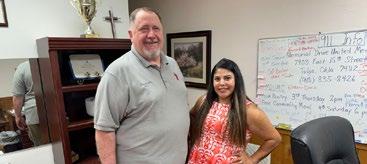
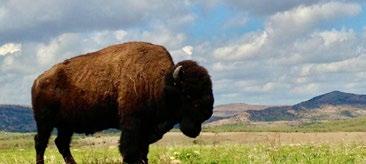
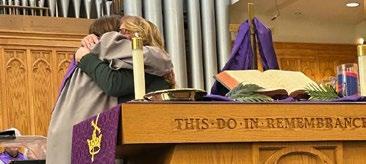
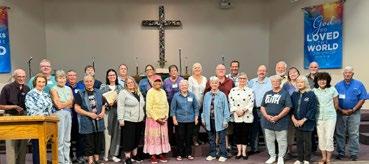







When Buster Hall was appointed to Memorial Drive UMC in Tulsa in 2023, the church was in negotiations to serve as a study space for a homeschool program. The congregation loved the idea of putting some of the church’s vast space on the east side of Tulsa to use.
When that plan didn’t come to fruition, then-District Superintendent Connie Gibson suggested Hall reach out to “The Matts.”
The Matts, as they are affectionately known, are the co-pastors of University United Methodist Church, Matt Austin and Matt Patrick.
Faced with a similar problem of empty building space, the Matts came up with a creative way to fund church needs while making safe, cost-effective space available for local businesses: the alternate income model.
The result were two businesses. Double Flag Coffee is a 20-foot mobile coffee company and is growing to include multiple brick-and-mortar locations.
Propel Business & Event Center is a commercial office and event space rental company. Office space tenants are local business owners, and space is available througout the large church building.

Janeth Bernal, a notary public in Tulsa, approached Hall at Memorial Drive UMC about renting office space. In a true light-bulb moment, Hall offered to trade office space in exchange for Bernal managing tenants. So far, all six tenants are Hispanicowned businesses, according to Bernal. Thankfully, Bernal is bilingual, fluent in both English and Spanish. The area around Memorial Drive UMC has a growing Hispanic population, with the percentage of residents jumping by 17 percent over ten years.
Bernal has not even had time to begin a marketing campaign; through word of mouth alone, she has brought in a boutique, a hair salon, a personal wellness shop, a fragrance shop, and a Spanish-language Alcoholics Anonymous group. She’s also brought in an Overeaters program and has Zumba classes at the church.
Bernal is very excited. “I’d like to add ESL classes, computer classes for beginners, and history classes for those who want to become citizens,” she said. Already, she has nearly

20 students ready for the English language program.
“I want to teach the history class,” interjected Patrick.
“Historically, the UMC has struggled to connect with this community,” said Patrick. “We’ve wanted to do it in our own way. But when we let it grow organically, we can get out of the way and let the community run it and grow what’s important to them.”
That’s why this has worked so well, according to Patrick. Bernal’s word-of-mouth technique has been to share Zumba classes on her personal Facebook page. That’s it. No snazzy paid advertisements, no canvassing the neighborhood.
“You can tell God is doing it, because we’re not even having to try,” said Patrick. “That’s what the Holy Spirit is doing.”
While this model of community relationships isn’t a direct funnel of tenants coming to worship, an indirect growth has taken place.
to do that, making those connections.”
“A man rented the fellowship hall for a birthday party for his daughter,” remembers Hall. “I gave him a tour of the facility. He saw the beautiful sanctuary. He stopped and closed his eyes, pausing for several seconds. Then he looked at me and said, ‘I feel God in this place.’”
most interested in working with rural churches, which are still unexplored.”
Patrick sees possibilities for agriculture, like flower farms, at churches with acreage. “Our church is changing, and we’re not powerless as the world changes around it,” he remarked. “We have everything we need to accomplish this task.”
He continued, “Each and every church has the ability to make the changes they need to make this work in their context, and will be shocked to see what these changes do.”

“We were 20 in worship when I started,” remarked Hall. Now we’re at 50. When people see what’s happening in the facility, they get excited to see what’s going on in the life of the church.”
“We cracked the door and God kicked it open,” added Patrick.
“We’re learning that in Hispanic culture, the church is a community center. We want this to be their community center, but also their church,” said Hall. “Janeth is helping
The facility is currently being updated. The bathrooms are finished, but much more is coming. When that happens, Hall, Bernal, and Patrick alike expect even more growth.
“We have a lot of fun here,” concluded Hall.
Patrick doesn’t see this strategy as being confined to metropolitan churches. In fact, stated Patrick, “we’re
“This strategy works,” Patrick concluded. “It not only improves your financial situation, but it also connects you to parts of the community that you weren’t connected to before.”
For congregations interested in learning more about the alternative income model, Patrick invites questions. Simply email thematts@uumctulsa.org.
BY ASK THE UMC
Read the entire “Our Living World” series here
The meaning of the word “religion” is “relinking.”
Religion describes the ways human cultures have sought to create, sustain, and renew links with one another, the world around them, and the powers or reality that lies behind it all. In this series, we explore how United Methodists seek to sustain and renew our links to our living world.
When we consider what it means to be re-linked with our living world, we remember God’s first charge to humankind, recorded in Genesis 1:28,

NRSVUE: “Have dominion over the fish of the sea and over the birds of the air and over every living thing that moves upon the earth.” In short, be stewards of all animals in this living world.
This commandment from Genesis mentions fish first, then birds, then living things on the earth. This reflects Israel’s profound and abiding connection to and dependence upon seas, both coastal and inland, as a primary means to provide life and livelihood. But it is just as important that animal life, wherever it is found – sea, air and land – is commended to our care.
United Methodists take seriously the charge to be good stewards of all animal life. Here is our statement on animal life from the Social Principles:
“We support regulations that protect and conserve the life and health of
animals, including those ensuring the humane treatment of pets, domesticated animals, animals used in research, wildlife, and the painless slaughtering of meat animals, fish, and fowl. We recognize unmanaged and managed commercial, multinational, and corporate exploitation of wildlife and the destruction of the ecosystems on which they depend threatens the balance of natural systems, compromises biodiversity, reduces resilience, and threatens ecosystem services. We encourage commitment to effective implementation of national and international governmental and business regulations and guidelines for the conservation of all animal species with particular support to safeguard those threatened with extinction.”

While this is the extent of official United Methodist statements about animal life, we find much here to unpack, consider and act upon as we seek to live as those re-linked with all other animals that inhabit our living world with us.
Just as the commandment in Genesis 1 to care for all animal life begins with the habitat of most significance to ancient Israel, so this section of the Social Principles on animal life begins with a reference to the animals nearest and dearest to many humans, our pets.
Many consider pets to be part of their families. We are invited, then, to contemplate the closeness of our relationships with all other animal life, from primates and other mammals, to birds, reptiles and amphibians, arachnids and insects, fish, cephalopods, mollusks and jellies, to single-celled creatures, such as bacteria and zooplankton.
The protection we seek to offer for all animal life through legislative and other initiatives is not solely for the sake of the animals themselves. It is for the sake of the good of the whole of our living world, the many ecosystems on our planet that make all of life possible.
is altering living conditions for all kinds of life, we care about helping animals to survive, even if they can no longer easily thrive.
Governmental regulation alone does not and cannot secure the safety of animal life. Much of what is required reaches beyond what governments have the authority or the ability to do. Governments are limited to acting within their political borders, borders which do not exist for animals. In many situations, businesses, rather than governments, may be better poised to respond.
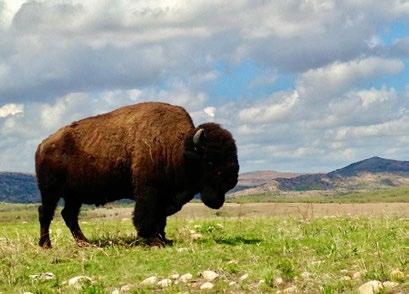

All of these are our animal neighbors, whose home is no less in this same living world than is our own. All require our diligent protection, whether from our overreach, our neglect or the result of circumstances we do not directly control.
We care about balance, and so may advocate to take steps to reduce the proliferation of species in areas where they have few, if any, natural predators.
We care about the diversity of life in all its forms, recognizing that each form of animal life has a place and makes an important contribution to the whole.
This is why United Methodists support the development and universal enforcement of international governmental and business policies for the sake of the welfare of all animal life, and particularly for those species that are most endangered.
In all these ways, United Methodists have committed ourselves to care for our living world, starting with our nearest relatives, the animals.
Ask The UMC is a ministry of United Methodist Communications.

BY MARLYS CERVANTES
Church attendance has been declining even prior to COVID, and since then many congregations have found it difficult to bounce back from where they were prepandemic. Nationwide, the struggle is real, with those who desire to continue in their worship and outreach looking for solutions to keep their doors open to serve their current members while they continue to look for ways to meet the needs within their communities.
In Ponca City, Oklahoma, First United Methodist Church and First Presbyterian Church have recently come together after months of collaboration in a partnership that very well may be a model that could work for other churches as well. But what led to the need for this? What made two previously vibrant churches struggle and led one to come close to the need to close their doors altogether?
olds) being less likely to belong to or attend church even if they identify with a particular religious group, such as Protestant Christian or Catholic.
However, there is a growing number of Americans with no religious affiliation. In the years 2001 to 2003, there were only nine percent who had no affiliation, but in 2021 to 2023, the numbers had grown to 21 percent.
What is maybe most interesting in all of this, especially since many of us tend to blame much of the decline on the recent pandemic, is to look
“Innovation is taking two things that already exist and putting them together in a new way.”
~Tom Freston, American Media Financier
at an earlier Gallop poll. In March 2021 Jones reported that U.S. church membership dropped below the majority for the first time since it had been tracked: “In 2020, 47 percent of U.S. adults belonged to a church, synagogue or mosque.”

First UMC in Ponca City hosts both United Methodists and Presbyterians in a unique partnership. Submitted photos.
In his article, “Church Attendance Has Declined in Most U.S. Religious Groups,” Jeffrey M. Jones states that a March 2024 Gallop poll indicates three in 10 U.S. adults attend religious services regularly, with 11 percent attending once a month and 56 percent seldom attending services. Only two decades ago, the U.S. averaged 42 percent attending every week or nearly every week (instead of the current 30 percent). One decade ago, the average was 38 percent.
It appears that the most likely reason is the rise in younger adults (18 to 29-year-
However, before that it had been much higher. Membership had been 70 percent in 1999 and dropped to 50 percent by 2018. When Gallop first measured U.S. church membership in 1937 it was 73 percent, which means it remained near 70 percent for the next six decades before the decline began. Again, much of this may be from a drop in religious affiliation, possibly when people move and don’t find new home churches, and due to those younger adults who never establish an affiliation.
This decline is precisely what happened for First Presbyterian Church. Ann Salmons, choir director at FPC, explained what they’ve experienced. ”For the past ten years, we have watched not only our people becoming fewer and the age of our members getting older, but also the growing cost of maintaining and repairing our facility. We tried many different avenues such as looking for organizations to rent part of the building, shutting off part of the building, or downsizing to another building.”
Salmons continued, “Our members were not ready to just close the doors to
our ministries. We strongly felt God had more for us to do. Our church still had a heartfelt call to reach people through worship and mission.”
First United Methodist Church had made changes due to a decreasing membership as well, moving from two worship services on Sundays to one and decreasing staff positions. They had moved services during COVID onto a local cable television and YouTube streaming, and the broadcast helped keep congregants informed about others whom they weren’t seeing regularly. However, as with any decision like this, it was then slow work moving people back into the pews once it was time, precautions still had to be taken. So, both churches were hurting.
Salmons mentioned that First Presbyterian’s (FPC) congregation felt God tugging them to investigate working with another church. So, with continuing low numbers, leaders from FPC approached Rev. Leon Veazey about possible solutions, and leaders from both congregations began discussing and brainstorming. After the discussions, pastors Leon Veazey and Mark Southard, along with leaders from the churches, believed the two churches would be good for one another. They suggested joining in partnership, with each keeping its own identity. Two denominations were joining together in their worship and missions. It had never been done before and, while it seemed a stretch, it felt like the perfect idea.
Gay Norris, a member of FPC and Clerk of the Session said, “I’d have to say that the sadness and trepidation of ‘leaving’ our long-time home has been replaced ten-fold by the incredible welcome we have received from our new church family. So many of us walked in being greeted by long-time friends and neighbors, and at the same time were embraced by total strangers that instantly are becoming new friends. I think FPC has found a vibrant, passionate church family. The union is truly a ‘road less traveled’ but is taking us on a healing journey for our congregation. I am beyond happy and hopeful!”
Norris’ counterpart from First UMC
in formally signing the partnership - once it was finally polished - was Teri Harris, First UMC member and chair of Church Council. Of the process and looking forward, Harris remarked, “As a leader and long-term member of the church, I have truly enjoyed this opportunity to worship together. I believe each church had strengths that the other did not, and our partnership will allow us together to reach more people in our community than ever before. From a theological perspective I believe we’ve just started to scratch the surface of what we can learn from one another.”
There are many areas where the two churches come together, and none are so obvious as in music. Director of Music Ministry at FUMC, Marta Sullivan, expressed her joy at the added fullness of the choirs: “The coming together of voices and bells has been a profound blessing. The additional talent has grown the Chancel choir from an average number of 15 singers to an average of 25 and the Carillon hand bell choir, struggling with enough ringers to play three octaves of bells, now has a surplus of ringers allowing the group to play five octaves of bells with a couple positions duplicated. This surplus of seasoned talent has not only extended the choir’s range but has also sparked the creation of a hand bell ensemble.”
For a church that had such a depth in its music program in the past, this growth has been welcomed by all. Sullivan said, “In addition to simply having a fuller and more robust sound with additional voices and bells, having more participants opens opportunities for offering more intricate and challenging musical pieces. This is especially true when the participants from both churches are highly talented with a wealth of experience. Directing these choirs has been a joy and I am truly overwhelmed with gratitude for the limitless worship opportunities that lie ahead.”
Rev. Leon Veazey,
FUMC senior pastor - and the pastor with oversight for worship and other ministry elements as the churches work together in the joint ministry - expressed the beauty of the ecumenical partnership between the two, saying, “The worship experience has been wonderful with the merger of two great choirs and hand bell ensembles, and an additional choir director who has already filled in for one service and served jointly with the choir director of FUMC on a couple of occasions. We also gained a soloist who is well-known in our community as a gifted vocalist. We have incorporated liturgy from the Presbyterian Church USA and utilized liturgists from their church in some of our worship services in order to honor both traditions.”
It would seem both congregations understand the joy and blessings of joining in this ministry and the beauty of diversity in worship. Volunteers from both congregations have joined in providing for the children’s and youth ministries, with both expected to grow as they move forward.
Possibly some of the most excitement has been the converging of mission ministries of the two congregations. Volunteers from both churches have come together in support of one another’s previous missions and helped ensure that all can continue. This is how service to God continues in great richness.
Salmons expressed this new ministry style as one in which God will do something wonderful. She said, “From the beginning, the congregation at First

A sweet celebration: the two congregations came together for cupcakes at a reception after their first joint worship service.
United Methodist Church have made us feel more than welcome; they have worked hard to help us feel at home. They have been wonderful to let us bring our mission opportunities and activities into their church life. We have joined our youth and our music departments, both congregations are supporting our Coryell Cupboard, our baskets with supplies for nursing homes and The Mission, and our Czech Camp Mission. They have opened their arms to us. It is sort of like relatives who have lived apart getting back together again. It is a joy!”
The partnership is not a merger. Each church retains its identity but enters into a “Memorandum of Understanding” (MOU) of partnership instead, with the purpose expressed as an agreement “for these two congregations to support each other in the fulfillment of their shared vision to effectively witness to the grace of Jesus Christ to make disciples for the transformation of the world,” and it specifically states the agreement is “in a spirit of mutual trust, respect, and shared commitment to Christian doctrine as each entity understands it.” No one is trying to change anyone else; both congregations are in support of each other.
The details of the agreement are specific and cover Mission, Responsibilities and Obligations (Intent of Agreement; Location and Property; General Pastoral Responsibilities;
Worship, Sacraments, and Pastoral Rites; Financial Management; Governance), Supervision, Terms of Understanding, and Ratification of MOU. There was an advisory team that met and fleshed out the details of the Memorandum, with consultants including one leader each from the greater organizations of United Methodist and Presbyterian Churches to oversee it.
commitment is there. Veazey said, “The body of Presbyterian parishioners who have been so committed to this enterprise express great character in their acceptance of this new chapter in their church life and have been so inspiring to us at First United Methodist Church! We are honored and pleased to call them part of our worship family!”
“Two are better than one, because they have a good return for their hard work.”
~Ecclesiastes 4:9
This is no small feat, and while the details - and time coming to them - were extensive, the coming together of people came with great ease. It felt like friends coming together since so many had been friends for years, or served on community organizations together already, or worked together. The advisory committee still meets regularly, with two lay members from each church, the pastor of FUMC and the presiding elder of FPC Session to work on details as the partnership moves forward.
However, most importantly, the

Now, the key is continued growth for all. In Gallop’s poll several points were mentioned that were key to what congregants want in their church. The primary reason they attended church was for a sermon that inspires them (no pressure, Pastor!). Other reasons were “spiritual programs geared toward children and teenagers, community outreach and volunteer opportunities, and dynamic leaders.”
If we are involved in our churches, we need to ensure the community around us knows what we offer—both internally for our members and externally for the community. Also, many young adults want a church that reaches out to the community. The togetherness in this partnership has helped these two churches do just that. FUMC and FPC have embraced one another and their missions in the community, and this will help them be vibrant in their worship services as well as throughout their service to their community.


Check out our monthly podcast to learn about what’s happening across the conference!



Last weekend the Southeast District had Lay Servant training at McAlester FUMC. Twenty-eight faithful people attended to learn more about living and sharing their faith. The Basic course was led by Rev. Larry Bauman, and the Advanced course was led by Ron Shepherd. It was an encouraging turnout, and they hope we have great attendance at the next Lay Servant training. Photo by Sonja Tobey.

New Day Camp volunteers are still reflecting on some of the connections that were made, or re-made, at the recent camp. Rev. Pam Cottrill, pastor at Inola UMC, served as a volunteer this year. She kept “eyeing” a Leader in Training (LIT), thinking that he looked familiar. She initiated a conversation with Gabriel and discovered that while serving in 2014 to 2015 at Nichols Hills UMC as associate pastor, she’d taught him in Sunday School and helped train him as an acolyte. Gabriel is still active at Nichols Hills and was a LIT with eight-year-old boys…… shepherding the youngsters in swimming in the lake at Cross Point camp, recreation, workshops, worship, and craft time.

Lou Kerr touched a lot of lives. Social icon, civic leader, mastermind, philanthropist, art historian and collector, and strategic connector, she was tops! She was the president and chair of the Kerr Foundation. She was also an active member of the Kiva Sunday class at Nichols Hills UMC. As a Criminal Justice and Mercy Ministries (CJAMM ) board member, she powered a lot of decisions and directions for our ministry. Lesa Rhoads and Keith Dobbs had the opportunity to present, on behalf of the CJAMM board, a proclamation of appreciation to Kerr’s children Laura and Steven.



Life at Epworth Villa is all about freedom. Freedom from home maintenance and chores. Freedom from having to drive all over town. Freedom from worrying about future needs. And when you’re free to live your best life, it’s amazing the joy that each day brings. Experience the freedom you deserve and check out our spacious cottages and beautiful apartments at EpworthVilla.org.
The Korean Ministry Plan of the General Board of Global Ministries is seeking to update information on Korean American clergy. If you are an active or retired clergy member, please click here to update your contact information.
The 2024 mentor training will take place on August 1, 2024, from 1 p.m. – 5 p.m. at the Oklahoma Methodist Ministry Center located at 1501 N.W. 24th St. Oklahoma City, OK 73106. This training is for candidacy, provisional and local pastor mentors. You can register here.
The 2024 Candidacy Summit will take place on August 2-3, 2024, at the Oklahoma Methodist Ministry Center located at 1501 N.W. 24th St. Oklahoma City, OK 73106. This training is for declared candidates, certified candidates and provisional members. You can register here.
Share your event or job opportunity in the Contact For consideration, email your listing to editor@okumc.org.